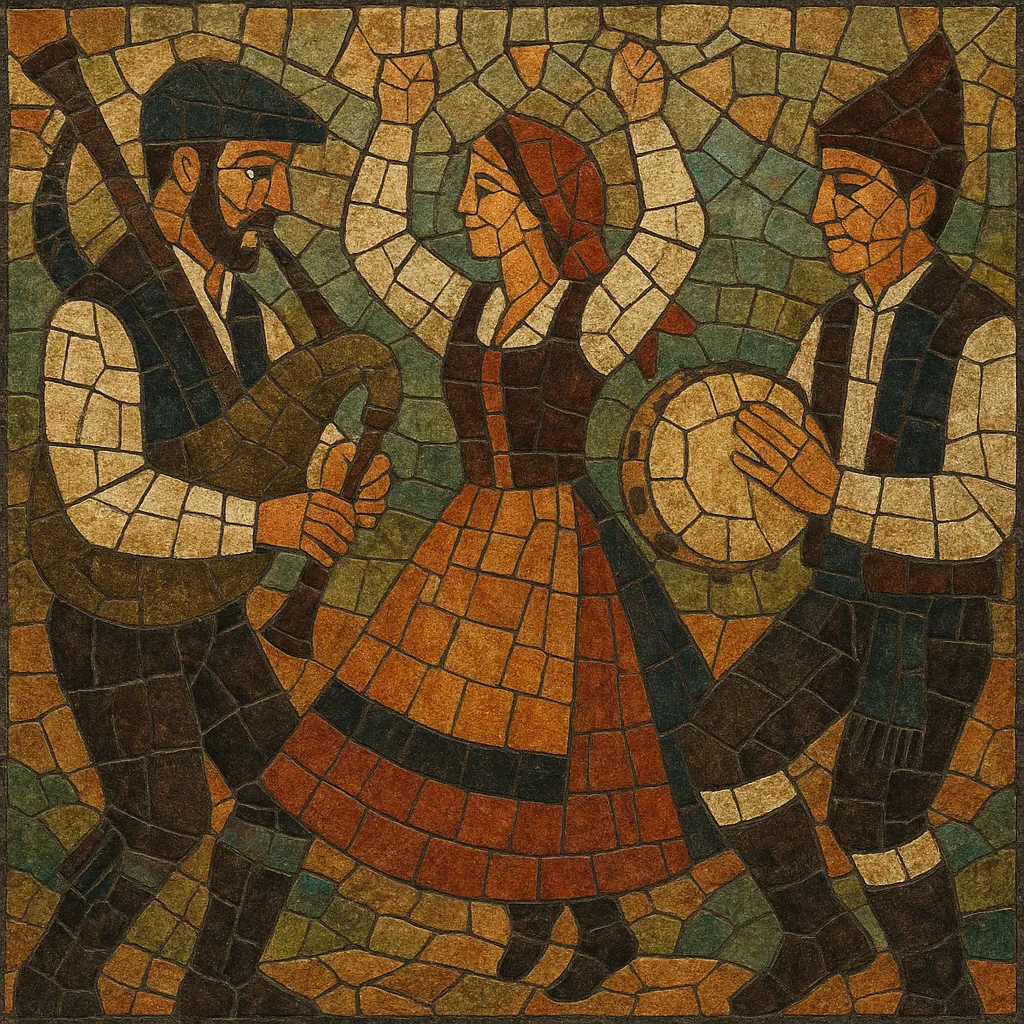Muiñeira is a traditional Galician dance-music genre from northwest Spain, closely related to the wider Atlantic Celtic family. It is most often in a lively 6/8 meter, comparable to the Irish jig, and is led by the Galician bagpipe (gaita) accompanied by tamboril (snare), bombo (bass drum), and pandeireta (tambourine), with occasional fiddle, flute, accordion, or hurdy-gurdy.
Tunes typically use binary forms (AABB) with 8- or 16-bar strains and abundant ornamental variation suitable for dancing. Melodies favor modal colors, especially major with a flat seventh (Mixolydian) or Dorian, fitting the gaita’s tuning and constant drone.
As a social dance, muiñeira is energetic and communal, with circle or pair formations, call-and-response shouts (aturuxos), and local variants such as the "Muiñeira de Chantada" or "Muiñeira de Lugo." It serves as both a cultural emblem of Galicia and a bridge between Iberian and pan-Celtic traditions.
The term "muiñeira" (literally “miller’s [dance]”) reflects rural origins around watermills and village festivities in Galicia. Although its roots likely extend earlier, the genre’s modern recognizable form crystallized in the 19th century alongside Galicia’s folk dance repertories and the prominence of the gaita, whose drone-based sonority and modal scale underlie the idiom.
During the Rexurdimento (Galician cultural revival) of the 1800s, collectors and musicians began documenting local tunes and dances, fixing common features such as 6/8 meter, binary strain structures, and regional variants. Muiñeira entered civic celebrations, romarías (pilgrimages), and town band repertoires, while gaiteiros (pipers) professionalized performance practice and ornamentation.
After periods of urbanization and migration that challenged rural traditions, a late-20th-century folk revival restored muiñeira’s visibility. Folk ensembles, dance troupes, and recording artists brought the genre to concert stages and international festivals. Ensembles expanded instrumentation (fiddle, accordion, hurdy-gurdy) while respecting gaita-led rhythmic drive and dance function.
From the 1990s onward, Galician artists collaborating with Irish, Breton, and Asturian musicians highlighted muiñeira’s Celtic kinship. The genre informed Celtic rock, world fusion, and contemporary folk productions, retaining its dance essence while adapting to modern stages and studios.
Muiñeiras are fast, buoyant 6/8 tunes, usually AABB with repeats and variation. Dancers use steps emphasizing the 1-and-4 pulse (3+3 feel), heel-toe figures, and spins, often punctuated by communal aturuxos (shouts). Distinct local versions—such as the Muiñeira de Chantada—have become emblematic standards.
Write in 6/8 with a bright, danceable tempo (around 100–120 dotted-quarter BPM). Emphasize the 3+3 jig feel by accenting beats 1 and 4; allow occasional 2+2+2 cross-accent (hemiola) for lift.
Lead with gaita (Galician bagpipe) over a drone. Support with tamboril (snare-like drum), bombo (bass drum), and pandeireta (tambourine). Optional colors include fiddle, flute/whistle, accordion, and hurdy-gurdy. Keep percussion patterns crisp and cyclical to anchor dancers.
Compose singable, motive-driven melodies spanning roughly an octave. Favor Mixolydian (major with flat VII) and Dorian modes, which suit the gaita’s tuning and drone. Use short motifs, stepwise motion, and idiomatic ornaments (grace-note cuts, taps, short rolls) to emulate gaiteiro phrasing.
Adopt a binary AABB form, each strain 8 or 16 bars, with repeats and variation on each pass. Harmony is simple and modal: pedal on I with cadences to bVII and V; avoid dense progressions. Drones or sustained tonic reinforce the modal center.
Keep textures uncluttered so the melody and dance pulse remain clear.
Start sparsely (drone + melody), then add percussion and counterlines. Use call-and-response between melody instruments or melody vs. percussion. Encourage aturuxos (shouted interjections) and dynamic swells at repeats. End with a final emphatic cadence or tag.


